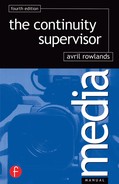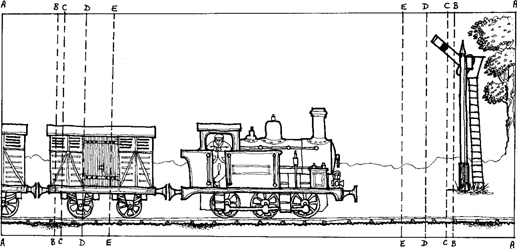The aspect ratio of film in the cinema was 4:3 (which can also be expressed as 1.33:1) dating back to the silent days. When television was invented, it took the same shape screen, and the proliferation of widescreen formats today dates back to the cinema’s attempt to win audiences away from television with a wider screen and colour in the first CinemaScope film, The Robe (aspect ratio 2.30:1) in 1953.
If you look at the drawing of a train opposite, the entire picture represents the aspect ratio of a Panavision feature film (A–A). A normal, modern non-anamorphic film at the cinema would exclude the tree, the signal post and part of the train (B–B) and conventional television would only include the locomotive and part of the first wagon (E–E). Other common ratios are marked on the illustration.
From the continuity point of view, the difficulty occurs in television where a programme may be made in 16:9 widescreen, protected for either 4:3 or 14:9. What this means is that essential information for the viewer (e.g. captions or, on the illustration, the railway locomotive and part of the first wagon), is contained within the narrower aspect ratio. For example, at the time of writing, drama made for the BBC is made in 16:9, and transmitted in 16:9 widescreen on the BBC–1 digital network. The analogue viewer of the same programme at the same time will see a 14:9 ‘letterbox’* picture on their 4:3 television set, and a version of the programme may be supplied to BBC Worldwide in 4:3 ratio. So the answer to the question ‘where is the edge of frame?’ is actually ‘in three places at once’! There is nothing the continuity supervisor can do about this problem but it is worth being aware of it.
PAs may be involved in post production with aspect ratio conversions of widescreen programmes for delivery in various formats. This is a highly technical area outside the scope of this book. It is essential to take advice from someone who knows what they are talking about!
| A: | 2.30:1 | Anamorphic wide cinema format, e.g. ‘Panavision’ |
| B: | 1.85:1 | Normal, modern, non-anamorphic cinema format |
| C: | 1.78:1 | Widescreen TV format, more usually known as 16:9 |
| D: | 1.55:1 | Compromise ‘letterbox’ format for transmission of widescreen programmes, on non-widescreen networks, more usually known as 14:9 |
| E: | 1.33:1 | Normal, i.e. non-widescreen shape of TV screens. Called the ‘Academy’ frame, it was also the shape of cinema screens until the film industry began to fight back against TV in the 1950s with wider screens. Also known as 4:3 |
* The term ‘letterbox’ means black bars at the top and bottom of a 4:3 television display, which make the aspect ratio of the picture wider than that of the screen.

